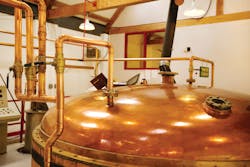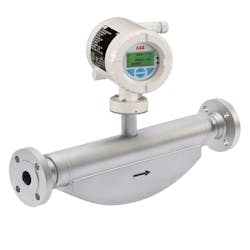Coriolis flowmeters help Scotch whisky producers meet strict regulations
Producing the perfect bottle of Scotch whisky is a complicated business, where accurate measurement is everything. Strict regulations around the taxation of alcoholic spirits, plus the added need to ensure a minimum alcohol content to qualify as an official Scotch, make it essential for whisky producers to ensure that the levels of alcohol in their beverage are exactly right.
Today’s whisky producers must satisfy strict regulations that were implemented over 100 years ago. In 1916, the U.K.’s Chancellor of the Exchequer, teetotaller David Lloyd George, was given the task of finding ways to raise money for the country’s war effort and attempt to curb alcohol consumption. One of the targets for his efforts was the whisky industry. After much protest from whisky producers, a compromise was met that agreed that a standardized strength of 42.9% alcohol by volume (ABV) would be implemented. Later in 1917 when Lloyd George became prime minister, a legal minimum alcohol content was agreed and was set at 40% ABV. This limit still endures today and is required for any spirit to be legally considered Scotch whisky.
Requirements for the measurement of the alcoholic contents of spirits, including Scotch whisky, are subject to strict regulations set down by Her Majesty’s Revenue and Customs (HMRC) in the U.K., the government body responsible for the collection of taxes. These regulations set out various key requirements, with producers obligated to submit quarterly production returns stipulating both the quantity of ingredients used and the amount of spirits produced. These returns must be accurate, with any deviations or errors potentially attracting financial penalties.
Another key requirement is the need to measure the alcoholic strength of the whisky itself. Regulation 18 of the Spirits Regulations 1991 calls for precise and accurate measurement of the density of the whisky during distillation, with measurements being taken at a temperature of exactly 20°C.
Further requirements are imposed by the Scotch Whisky Regulations 2009. Under these regulations, for a spirit to be called Scotch whisky, it must be matured in oak casks not exceeding 700 liters in capacity for a period of no less than three years. These casks, which cannot leave Scotland, must be situated in an excise warehouse or other permitted place, with the whisky then being transferred at the end of the maturation process.
During the maturation period, which can range up to 15 years or more depending on the product, the whisky must be kept at less than 94.8% ABV, which not only maintains alcohol content but also ensures the whisky has the correct taste and aroma derived from its raw materials.
Requirements are equally stringent when it comes to moving the whisky from one place to another. With excise duty on spirits chargeable as soon as they are taken out of warehouse storage, the quantities of whisky being transferred need to be carefully measured to avoid any errors that could increase the amount of duty levied.
Making the difference between Scotch and not
In basic terms, the ABV level of whisky is defined as the number of milliliters (ml) of pure alcohol present in 100 ml of the whisky at 20°C. To derive this figure, the mass of the alcohol must be divided by its density at 20°C.
The strict requirements for what can officially be called a Scotch whisky require ABV levels to be closely measured and controlled. If whisky is distilled at a level above 94.8%, for example, it will be considered by law as neutral, as Scotch must be produced containing the right taste and aroma. Equally, after distillation and during the cask process, the alcohol concentration needs to be at a strength of 63.5% ABV to ensure the taste and quality of the whisky is of the highest standard.
The ability to accurately measure the ABV of whisky during the distillation process is particularly important when it comes to estimating the excise duties on the whisky. As this is based on the liters of alcohol contained in the final product, it is important to ensure that the measurement is correct, especially as any discrepancies can result in the imposition of added duty.
Capable of measuring mass and volume flows as well as density, Coriolis flowmeters provide the ideal solution for both whisky distillation and custody transfer, due to the following:
Straight tube designs operate in a similar manner. The vibrating tube is fixed at its ends, creating two rotating reference frames. The rotations at the inlet and outlet sides are in opposite directions, creating opposing Coriolis forces that distort the tube.
In most designs, the tube oscillates at its resonant frequency, which depends on the meter tube geometry, the characteristics of the flowmeter materials, and the mass of the fluid in the meter tube. Using these properties, it is possible to calculate the fluid density within the tube, making Coriolis flowmeters ideal for measuring the alcohol density of the whisky. The flowmeter also includes a thermal sensor to account for dimensional and elasticity changes of the tube with fluid temperature, which eliminates any potential errors in the mass flow measurement.
Furthermore, because the Coriolis metering principle is independent of the fluid's density, temperature, viscosity, pressure and conductivity, it is independent of Reynolds number as well as upstream and downstream flow velocity profiles. Consequently, Coriolis flowmeters require no straight runs of piping on either side, reducing both installation space and cost.
A key benefit of Coriolis meters is their accuracy. Accuracies of ABB’s CoriolisMaster flowmeter models, for example, range from 0.1% to 0.4% of reading for liquids and 0.5% to 1% of reading for gases.
Such accuracy means whisky distillers can ensure they are providing HMRC with the most accurate measurements for both the quantity and density of whisky produced, which can then be used to calculate the appropriate level of tax.
The requirement to turn mass measurements into volume flow to meet HMRC requirements can also be satisfied by Coriolis flowmeters. Instruments such as ABB’s CoriolisMaster can make the necessary conversions and calculations via the flow transmitter, with the output being relayed to the distillery control system.
Conclusion
With such tight controls on the production and taxation of Scotch whisky, the need to ensure accurate measurement throughout the distillation and custody transfer stages is of paramount importance. When coupled with their ability to enable accurate calculation of excise duties, Coriolis flowmeters offer the perfect solution for whisky production.
Despite carrying a larger upfront cost than other flowmeter technologies, the performance and operational savings benefits of Coriolis flowmeters enable them to eclipse the short-term purchase savings offered by lower cost technologies.
David Bowers is a product manager of pressure and process flow for ABB Measurement & Analytics. Go to abb.com/measurement for more information.



